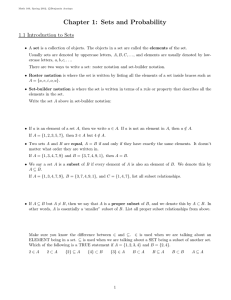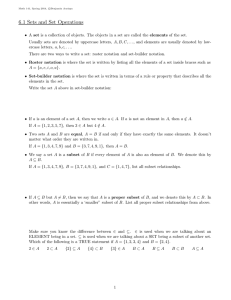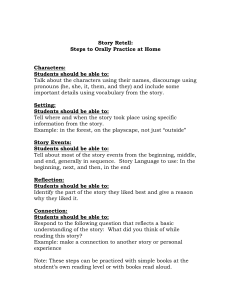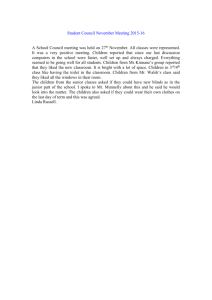Document 10504233
advertisement
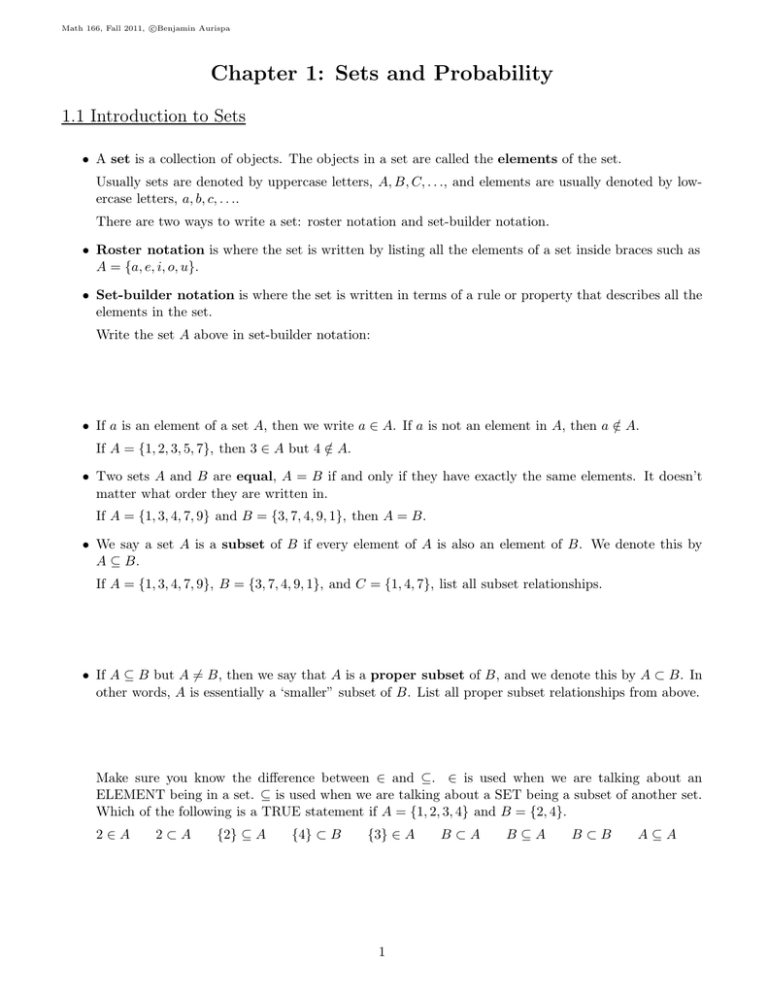
c
Math 166, Fall 2011, Benjamin
Aurispa
Chapter 1: Sets and Probability
1.1 Introduction to Sets
• A set is a collection of objects. The objects in a set are called the elements of the set.
Usually sets are denoted by uppercase letters, A, B, C, . . ., and elements are usually denoted by lowercase letters, a, b, c, . . ..
There are two ways to write a set: roster notation and set-builder notation.
• Roster notation is where the set is written by listing all the elements of a set inside braces such as
A = {a, e, i, o, u}.
• Set-builder notation is where the set is written in terms of a rule or property that describes all the
elements in the set.
Write the set A above in set-builder notation:
• If a is an element of a set A, then we write a ∈ A. If a is not an element in A, then a ∈
/ A.
If A = {1, 2, 3, 5, 7}, then 3 ∈ A but 4 ∈
/ A.
• Two sets A and B are equal, A = B if and only if they have exactly the same elements. It doesn’t
matter what order they are written in.
If A = {1, 3, 4, 7, 9} and B = {3, 7, 4, 9, 1}, then A = B.
• We say a set A is a subset of B if every element of A is also an element of B. We denote this by
A ⊆ B.
If A = {1, 3, 4, 7, 9}, B = {3, 7, 4, 9, 1}, and C = {1, 4, 7}, list all subset relationships.
• If A ⊆ B but A 6= B, then we say that A is a proper subset of B, and we denote this by A ⊂ B. In
other words, A is essentially a ‘smaller” subset of B. List all proper subset relationships from above.
Make sure you know the difference between ∈ and ⊆. ∈ is used when we are talking about an
ELEMENT being in a set. ⊆ is used when we are talking about a SET being a subset of another set.
Which of the following is a TRUE statement if A = {1, 2, 3, 4} and B = {2, 4}.
2∈A
2⊂A
{2} ⊆ A
{4} ⊂ B
{3} ∈ A
1
B⊂A
B⊆A
B⊂B
A⊆A
c
Math 166, Fall 2011, Benjamin
Aurispa
• The empty set is the set that contains no elements and is denoted by ∅ or by {}.
FACT: The empty set is a subset of EVERY set. For any set A, ∅ ⊆ A or {} ⊆ A.
Example: List ALL subsets of the set C = {1, 4, 7}.
If a set A has n elements in it, then the total number of subsets of A is 2n .
.
The number of proper subsets of A is
If A contains 4 elements, how many subsets does A have?
Proper subsets?
• A universal set is the set of all elements of interest in a particular discussion. It can vary depending
on the problem.
• A Venn diagram is a visual representation of a set.
Examples: Draw Venn diagrams to illustrate the following scenarios.
A is a proper subset of B. (A ⊂ B).
A and B have no elements in common.
Set Operations
• The union of two sets A and B, written A ∪ B, is the set of all elements that are IN A OR B OR
BOTH. This is the analog to ∨, the inclusive disjunction, in logic.
2
c
Math 166, Fall 2011, Benjamin
Aurispa
• The intersection of two sets A and B, written A ∩ B, is the set of all elements that A and B have
in common. In other words, it is the set of elements that are IN BOTH A AND B at the same time.
This is the analog to ∧, the conjunction, in logic.
If two sets A and B have no elements in common, then A ∩ B = ∅ and we say A and B are disjoint.
• The complement of a set A, written Ac is the set of all elements that are NOT IN A (but still in the
universal set U of the problem). This is the analog to ∼, the negation, in logic.
Example: Let U = {n, 2, 3, 4, w, 6, 7, 8, 9}, A = {n, w, 7}, B = {x|x is an even number between 1 and 9},
C = {n, 3, 4, 9}. Find the following sets.
• A∪B
• A∩C
• Cc
• A ∩ (B ∪ C)c
• (Ac ∩ C) ∪ B c
3
c
Math 166, Fall 2011, Benjamin
Aurispa
Sets: U = {n, 2, 3, 4, w, 6, 7, 8, 9}, A = {n, w, 7}, B = {x|x is an even number between 1 and 9},
C = {n, 3, 4, 9}
• (A ∪ B ∪ C)c
• (A ∩ B ∩ C)c
Properties of Set Operations
1. U c = ∅ and ∅c = U
2. (Ac )c = A
3. A ∪ Ac = U
4. A ∩ Ac = ∅
De Morgan’s Laws:
• (A ∪ B)c = Ac ∩ B c
• (A ∩ B)c = Ac ∪ B c
You can think of these De Morgan’s Laws as a kind of distributive property for sets.
Verify the first De Morgan Law using a Venn diagram.
A
B
A
B
A
B
A
B
4
c
Math 166, Fall 2011, Benjamin
Aurispa
Consider the following sets. Let U be the universal set of all undergraduate students at Texas A&M.
M = {x ∈ U |x is a male}
F = {x ∈ U |x is a freshman}
S = {x ∈ U |x is a senior}
Using these three sets, write the set that represents the following statements.
The set of students at A&M who are male freshman.
The set of students at A&M who are male seniors or female freshmen.
The set of female students at A&M who are not seniors.
The set of students at A&M who are neither freshman nor seniors.
What do the following sets represent in words?
Mc ∪ F
M ∩ (F ∪ S)
Consider the following 3 sets in the same universal set of undergraduate students at A&M.
I = {x ∈ U |x has an iPod}
D = {x ∈ U |x has a digital camera}
L = {x ∈ U |x has a laptop}
Using these three sets, write the set that represents the following statements.
The set of students at A&M who have an iPod and a digital camera but not a laptop.
The set of students at A&M who only have a digital camera.
What does the set I ∪ D ∪ L represent in words?
Shading Venn Diagrams
Shade the appropriate region in a 3-circle Venn diagram.
A ∩ Bc ∩ C c
A
B
b
a
c
e
d
f
g
C
h
5
c
Math 166, Fall 2011, Benjamin
Aurispa
(A ∩ C) ∪ (B ∩ C c )
A
B
b
a
c
e
d
f
g
C
h
(B c ∪ C) ∩ (A ∪ C c )
A
B
b
a
c
e
d
f
g
C
h
(Ac ∪ B)c ∩ C
A
B
b
a
c
e
d
f
g
C
h
6
c
Math 166, Fall 2011, Benjamin
Aurispa
1.2 The Number of Elements in a Set
We denote the number of elements in a set A as n(A).
.
If A = {1, 6, a}, then n(A) =
If B = {x | x is a consonant in the alphabet }, then n(B) =
n(∅) =
Example: In a room of 100 students, 30 are juniors, 50 are female, and 10 are both juniors and females. Fill
in the Venn diagam below with the appropriate number of students in each region. Describe the students
in region a.
J
F
b
a
c
d
Counting n(A ∪ B):
A
B
A
B
Union Rule
If A and B are any two finite sets, then the following formula holds.
n(A ∪ B) = n(A) + n(B) − n(A ∩ B)
If A and B are disjoint, the formula reduces to:
n(A ∪ B) = n(A) + n(B)
Example: 50 people were surveyed about whether they like the ice cream flavors vanilla and strawberry. 20
people liked vanilla. 25 people liked strawberry. 30 people liked vanilla or strawberry.
(1) How many people liked both vanilla and strawberry?
(2) How many people liked only strawberry?
(3) How many people liked neither?
(4) How many people like exactly one of these two flavors?
V
S
b
a
c
d
7
c
Math 166, Fall 2011, Benjamin
Aurispa
Example: A survey was done of 200 8-year olds asking if they like certain types of vegetables (broccoli,
carrots, green beans). The following results were obtained:
28 kids only liked green beans.
73 kids liked broccoli.
40 kids liked broccoli and green beans.
79 kids liked exactly 2 of these vegetables.
12 kids liked broccoli and carrots, but not green beans.
34 kids only liked carrots.
104 kids liked carrots or green beans, but not broccoli.
B
C
b
a
d
e
c
f
g
GB
(1)
(2)
(3)
(4)
How
How
How
How
many
many
many
many
kids
kids
kids
kids
h
liked carrots, but not green beans?
liked exactly 1 of the three vegetables?
liked broccoli or green beans?
do not like carrots?
Example: A survey was conducted of students at a liberal arts college to determine the foreign language
courses they had taken while undergraduates at the college. The results are given below.
200 had taken a Spanish class.
n(F ∩ G) = 18
316 had taken a Spanish or a German class.
282 had taken a French or a German class, but not both.
69 had taken a class in at least 2 of these 3 languages.
135 had not taken a Spanish or a French class.
n(S ∩ F ∩ Gc ) = 30
3 had taken classes in all 3 languages.
S
F
b
a
d
e
g
G
(1)
(2)
(3)
(4)
How many students were surveyed?
How many had taken a class in at least one of the three languages?
How many had taken a class in exactly two of the three languages?
Calculate n((S ∪ G) ∩ F c ).
8
c
f
h
c
Math 166, Fall 2011, Benjamin
Aurispa
Additional Challenging Honors Example:
You are given the following information about sets A, B, and C.
1. 15 elements are in A, but not in C.
2. 12 elements are in B, but not in C.
A
B
b
3. 9 elements are only in A or only in B.
a
c
e
4. 18 elements are in exactly 2 of the 3 sets.
d
5. 27 elements are in B and and in at least one of the other two sets.
f
g
C
6. 11 elements are in A and in C.
h
7. 13 elements are not in A or B.
8. 14 elements are only in B or only in C.
• Determine the number of elements in each of the 8 regions in the Venn diagram.
Hint: You will have to solve a system of equations.
Example: Solve the system. (We will learn an easier way to solve systems later this semester.)
x+y =8
x + z = 11
y + z = 13
• For each of the 8 statements above, write the set described using set notation.
In other words, use A, B, and/or C and the symbols ∩, ∪, and C .
Note: For some of them, there is more than one way to represent the set.
Example: Write the set of elements that are in at least 2 of the three sets using set notation.
9
